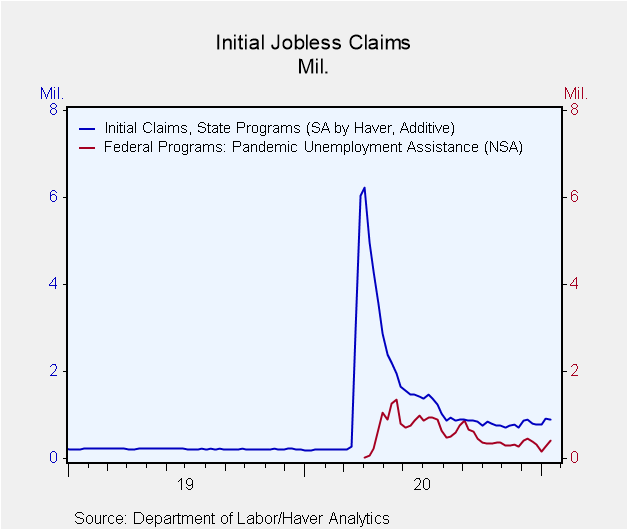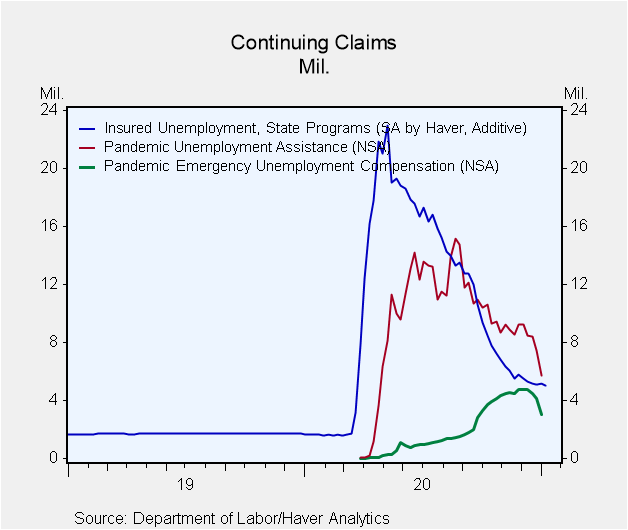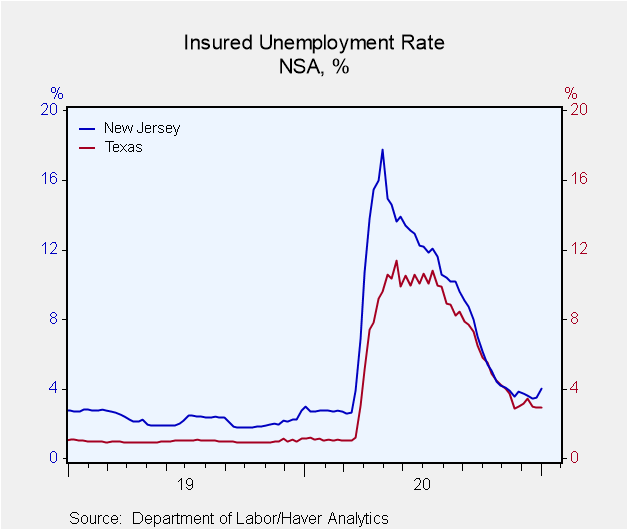 Global| Jan 21 2021
Global| Jan 21 2021U.S. Initial Jobless Claims Ease, but Are Still High
Summary
• State initial claims fall but PUA claims climb. • Continuing claims reverse prior week’s increase. • Insured jobless rate revised down a bit; now hovering at 3.5%-3.6%. Initial claims for unemployment insurance fell to 900,000 in [...]
• State initial claims fall but PUA claims climb.
• Continuing claims reverse prior week’s increase.
• Insured jobless rate revised down a bit; now hovering at 3.5%-3.6%.
Initial claims for unemployment insurance fell to 900,000 in the week ended January 16 from 926,000 the prior week, which was revised from 965,000. The latest week was very close to the Action Economics Forecast Survey estimate of 903,000.
As we continue to point out, the Labor Department changed its seasonal adjustment methodology back in August from multiplicative to additive. They did not restate the earlier data, so there is a break in the series in late August. Though the current comparison to early September is valid, comparisons with figures before August 22 are not. Haver Analytics has calculated methodologically consistent seasonally adjusted claims series dating back to 1979. This series matches the Department of Labor seasonally adjusted series since their change in methodology. For more details, please see the September 3 commentary on jobless claims.
Initial claims for the federal Pandemic Unemployment Assistance (PUA) program, which covers individuals such as the self-employed who are not included in regular state unemployment insurance, increased again in the latest week to 423,734 from the prior week’s 284,886; that earlier figure was marginally revised from 284,470. Note that the brief history of this program, starting on April 4, 2020, means these data and other COVID-related series are not seasonally adjusted. Thus, the increases in the last couple of weeks may simply reflect a return to regular business schedules after the Christmas and New Year’s holidays.
Continuing claims for regular state unemployment insurance decreased to 5.054 million in the week ended January 9 from 5.181 million the week before; that earlier week was revised down from 5.271 million. Continuing PUA claims, which are lagged an additional week and not seasonally adjusted, declined to 5.707 million; this covers the week ended January 2 and is the lowest level since late April. Again, this latest week’s move may be holiday-related. Similarly, the Pandemic Emergency Unemployment Compensation (PEUC) claims also decreased in the January 2nd week, reaching 3.027 million from 4.166 million the week before. This program covers people who were unemployed before COVID but exhausted their state benefits and are now eligible to receive benefits through March 11, 2021.
The total number of state, federal and PUA and PEUC continuing claims decreased in the January 2 week to 15.995 million, down from the prior week’s 18.407 million and the smallest amount since April 4.
The seasonally adjusted state insured rate of unemployment was 3.6% in the week ended January 9, the same as the prior week’s amount, which was revised down from 3.7%. The last five weeks have been “range-bound” at 3.5% or 3.6%.
The state insured rates of unemployment – which do not include the special federal programs – continued to show wide variation. In the week ended January 2, Alabama had the lowest rate at 0.88% and Kansas posted the highest at 7.49%. The larger states ranged between 2.05% for Florida and 7.18% for Pennsylvania. Texas was 2.94%, New York 5.09%, Illinois 5.58% and California 5.75% These state rates are not seasonally adjusted.
Data on weekly unemployment claims going back to 1967 are contained in Haver's WEEKLY database, and they are summarized monthly in USECON. Data for individual states are in REGIONW. The expectations figure is from the Action Economics Forecast Survey, carried in the AS1REPNA database.
| Unemployment Insurance (SA, 000s) | 01/16/21 | 01/09/21 | 01/02/21 | Y/Y % | 2020 | 2019 | 2018 |
|---|---|---|---|---|---|---|---|
| Initial Claims | 900 | 926 | 784 | 309 | 1,450 | 218 | 221 |
| Initial Claims (NSA) | 961 | 1,112 | 920 | 241 | 1,367 | 218 | 221 |
| Initial Claims Pandemic Unemployment Assistance (NSA) | 424 | 285 | 161 | -- | -- | -- | -- |
| Continuing Claims | -- | 5,054 | 5,181 | 191 | 10,664 | 1,701 | 1,756 |
| Continuing Claims (NSA) | -- | 5,563 | 5,767 | 160 | 10,358 | 1,704 | 1,763 |
| Insured Unemployment Rate (%) | -- | 3.6 | 3.6 |
1.2 |
7.3 | 1.2 | 1.2 |
Carol Stone, CBE
AuthorMore in Author Profile »Carol Stone, CBE came to Haver Analytics in 2003 following more than 35 years as a financial market economist at major Wall Street financial institutions, most especially Merrill Lynch and Nomura Securities. She has broad experience in analysis and forecasting of flow-of-funds accounts, the federal budget and Federal Reserve operations. At Nomura Securites, among other duties, she developed various indicator forecasting tools and edited a daily global publication produced in London and New York for readers in Tokyo. At Haver Analytics, Carol is a member of the Research Department, aiding database managers with research and documentation efforts, as well as posting commentary on select economic reports. In addition, she conducts Ways-of-the-World, a blog on economic issues for an Episcopal-Church-affiliated website, The Geranium Farm. During her career, Carol served as an officer of the Money Marketeers and the Downtown Economists Club. She has a PhD from NYU's Stern School of Business. She lives in Brooklyn, New York, and has a weekend home on Long Island.









